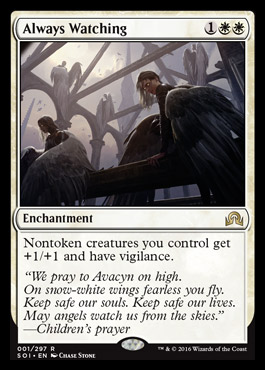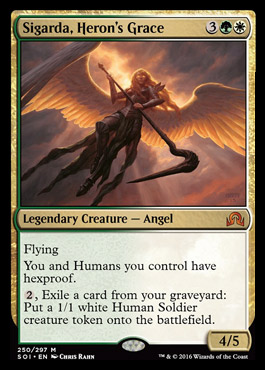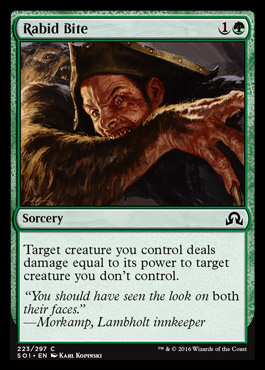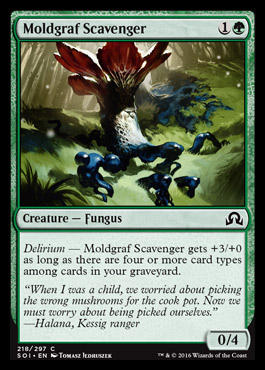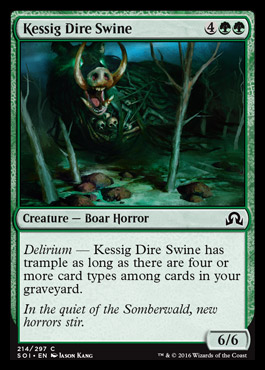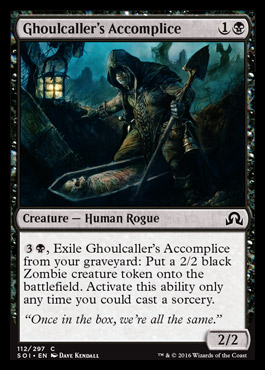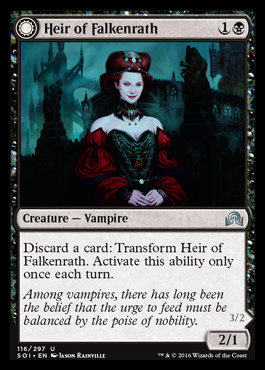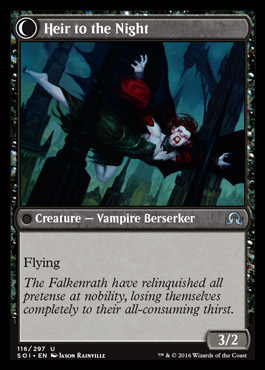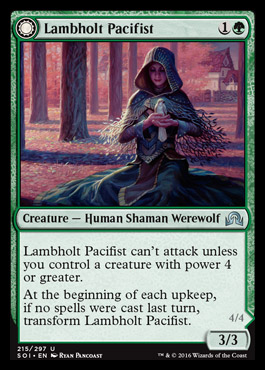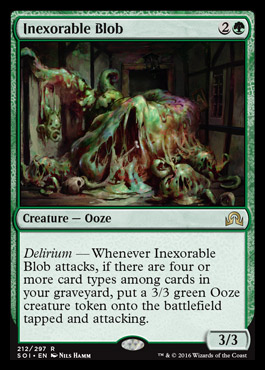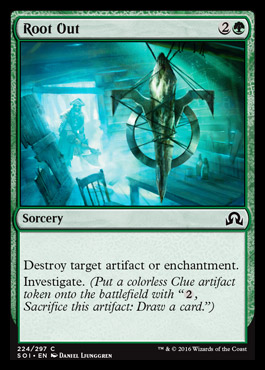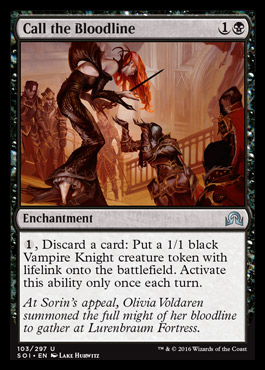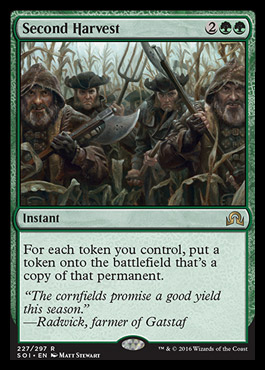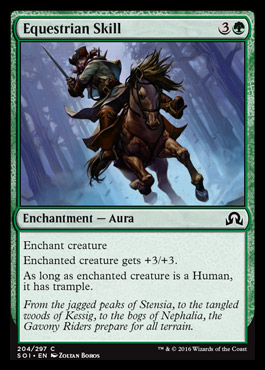I recently had the pleasure of attending two Shadows Over Innistrad pre-releases, the newest set for Magic: the Gathering. For those not in the know, the format of a pre-release event is always Sealed Deck. This means each player opened 6 packs of the new set (+1 random rare promo card) and constructed a 40 card deck using only those cards and basic lands provided by the shop.
There were some memorable back-and-forths, dramatic blow-outs, and weaselly under-performer cards. Here are some of the mental notes I took as I played, in the time-honored tradition of The Good, The Bad, and The Ugly.
Note that I'm only mentioning cards with which I had personal experience.
THE GOOD
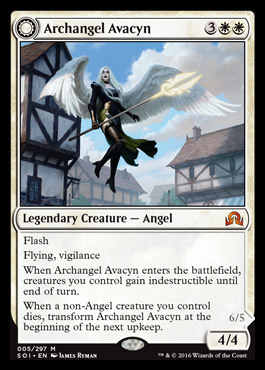
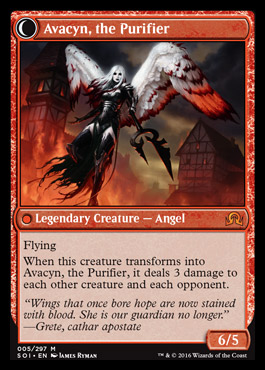
I didn't even open any copies of
Archangel Avacyn, but I played against a few and I am pretty sure that this card is good. Look at the text box on that thing! It's going to take you a solid minute just to read everything on both sides and absorb the information. You can be certain that well-running decks the country over were particularly likely to be packing a copy of Avacyn.
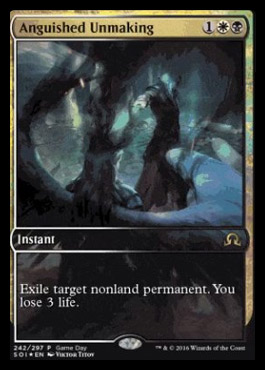
FLAVOR VICTORY: I cast Anguished Unmaking on an opponent's Archangel Avacyn the turn she came into play. Felt great, and not just because it was my only hope of survival, but because Avacyn is literally being melted by her dad in the card's art. Tough love.
Always Watching: I'm always watching for a good anthem board pump in limited formats, and this is a crazy powerful anthem effect, particularly if you're packing creatures that can block and survive the fight. It fits right in with an aggressive red-white strategy, but I had extraordinary results in a green-white build full of already stocky creatures like my new 0/4 Delirious Fungus Friend, Lambholdt Pacifist, and various werewolves. Just be vigilant about that first word on the card: "Nontoken". Your zombie and spirit friends won't be joining in on the fun. They'll just have to watch.
Sigarda, Heron's Grace: Add Sigarda to the list of creatures that cause opponents to panic the moment she hits the board.
She doesn't protect herself except in fringe cases of opposing Diabolic Edict-style effects, but if she sticks to the board, the win is nearly inevitable. Swinging for 4 in the air and then turning the graveyard into brave chump blockers until the win is a line of play that's going to drive removal-light decks daffy for many months to come. An unfortunate friend of mine faced an opponent packing not one but two Sigarda, Heron's Grace. Even more unfortunately, I was not that opponent.

Wild-Field Scarecrow: The only thing scary about this scarecrow is how good he is. I had two copies for my GW delirium deck splashing red for a copy of Nahiri, and he consistently did work. He's a 1/4, so he makes a great blocker against aggressive decks. When you feed him 2 mana, he explodes into 2 basic lands for your hand and puts an artifact and a creature into your graveyard to turn on delirium, which can act as an (admittedly on-board) combat trick. I used him to fix for a missing color, hold the line against aggro, and enable delirium several times each across just 5 rounds. The power level on this guy really came out of left field for me.

Angelic Purge: Unlike
the movie, this card is amazing exactly once per deck. It hits all three most-relevant card types in limited formats and exiles it (preventing delirium), which is pretty much the best a removal spell can aspire to be at common aside from being instant too. You can use the sacrifice to put another card type in your own graveyard for delirium to boot, such as a land. The cost becomes prohibitive to pay a second time in a single game, but I'm going to run two anyway if I open two.
Rabid Bite: A+ for the art alone.
Moldgraf Scavenger: This is exactly the type of common I love. He starts out as a great wall for a deck with a few heavy hitters at the 5 and 6 drop slot, and if you can scavenge up enough delirium enablers, you are rewarded with a creature that is functionally way above curve, and at common rarity you could conceivably have 2 or 3 of these guys. I expect him to validate green+something delirium as an archetype almost entirely on his own. Also pairs great with our new scarecrow friend pictured above.
Kessig Dire Swine: You can be a big pig too! It's not flashy or exciting, but as far as big dumb green common beaters go, this is my favorite of the last few sets. By the time you're slamming 6 drops, you're fairly likely to have delirium online, and trample is a big deal on a 6/6. If you untap and can swing with this guy, then your opponent's chances of winning look dire.
Ghoulcaller's Accomplice: A bear with substantial upside in black? Great! Works well in a "cares about humans" white/black deck, but can answer the call in any deck playing black pretty comfortably.
Heir of Falkenrath / Heir to the Night: Against some removal-light decks, slapping an equipment or aura on this vampire and swinging in the air is going to end the game on its own. The heir is perfectly passable, though not exciting, as a 2/1 who threatens a madness card. The fact that sometimes you can use a 3/2 flier to win the game is gravy.
Lambholt Pacifist / Lambholt Butcher: This card can slaughter your opponents at an unfair rate, but she needs a little bit of help. A Gryff's Boon is particularly nuts here: turn 3, you swing with a 4/3 flier. If your opponent has no spell the following turn, she becomes a 5/4 flier, and your opponent is super duper dead. Other auras and equipment are equally acceptable ways to "convince" her to swing.
THE BAD
Inexorable Blob: I want to clarify that this guy isn't actually "bad", persay. He's a 3/3 for 3 mana with only 1 green required, which is a fair rate in any color, although less impressive in green. What I'm more wary about, and want other people to realize, is that you're probably never going to live the Delirious Dream of swinging in with your blob turn after turn, popping out new baby blobs on the path to victory. Besides that scenario requiring Delirium (a task on its own), it would require your opponent to have nothing on board capable of blocking and killing a 3/3. An opponent that meets such criteria is already inexorably losing. Maybe a free blob would help seal that fate a turn earlier, but that's about it.
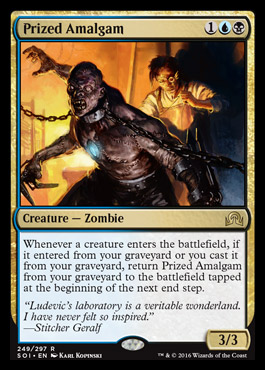
Prized Amalgam: There's a pretty nice prize for meeting this amalgam's deckbuilding demands, but there are far, far fewer ways to do so at common and uncommon than you might think. The creatures that exile themselves to put tokens onto the battlefield don't trigger the amalgam. If you have the good fortune of getting a Relentless Dead to pair with this guy, then you're probably going to grind out a few wins from that value alone. For the rest of us, this is the Blob again, but with 2 color requirements.
Root Out: This card will feel bad to have sitting in your hand occasionally, but you're going to end up playing it because of how many powerful enchantments and equipment are hanging out at uncommon rarity in this set. Pick one up while drafting if you can as insurance against shenanigans like Always Watching or Slayer's Plate.
Call the Bloodline: I'm going to call this card a trap that leads to deceptively bad lines of play. Turning cards into 1/1 lifelink chump blockers, even low-impact cards, is not something I want to do even for free. Similarly, although this technically enables delirium, compare the payoff here to other enablers like Angelic Purge, Wild-Field Scarecrow, or even that Shard of Glass equipment. There's a hypothetical black-red vampire deck that has enough madness outlets and vampire tribal to justify playing a copy of this card, and I sincerely hope I never play against it, because it would be nuts. Everyone else should avoid this card.
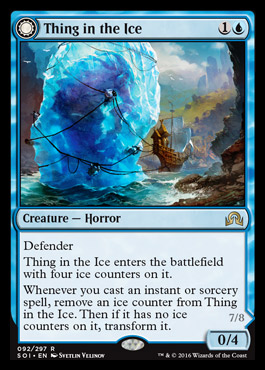
Thing in the Ice: This card is so fun and I totally understand the temptation to play it, but unless it's in your opening hand and goes completely unanswered, the odds of this Thing flipping are low. It's far too easy to build a bad deck for the sake of the dream of flipping this guy, throwing away game after game in the process. This horror is better left on ice.
THE UGLY
Second Harvest: The win-more nature of this card is right there in the name: to have a second harvest, you need to have a first harvest, and I'd say the majority of games you're losing will involve a lack of first harvest i.e. board presence through tokens. I've never been more underwhelmed than I was when I saw this card played against me to zero effect right before my victory. I don't think this card is viable in any format besides Commander because it's so win-more, but I can tell you it's definitely never going to live up to the mana cost in Sealed. Don't put this card in your deck.
Equestrian Skill: Doesn't give Horsemanship, garbage card
(in reality this card is perfectly fine if you have cheap fliers, a lot of humans, a lack of playables, or all three).
 A few month ago, there was simply no way I could have recommended Magic Duels to anybody. It was too glitchy and featureless.
A few month ago, there was simply no way I could have recommended Magic Duels to anybody. It was too glitchy and featureless.


